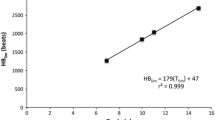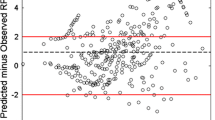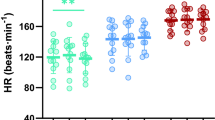Summary
It was the purpose of this investigation to: 1) compare the ratings of perceived exertion (RPEs) in high and low fit individuals when walking and running at comparable exercise intensities and 2) to determine if ventilation\(\left( {\dot V_E } \right)\) provides a central signal for RPEs. Nine high fit and nine low fit male subjects completed two exercise bouts on a treadmill, one uphill walking and the other level running. Workloads for each bout were set at 90% of each subject's ventilatory threshold (VT) as determined from a graded exercise test. Oxygen consumption\(\left( {\dot V_{O_2 } } \right)\) heart rate (HR), and\(\dot V_E\) were all similar between the walk and run trials for the low fit subjects (P>0.05). HR were found to be significantly greater during the walk trial vs. the run trial (P<0.05) for the high fit subjects, whereas,\(\dot V_E\) was significantly greater during the run trial. Oxygen consumption was similar for the high fit subjects during both trials (P>0.05). During the walk and run trials, central (12.1±.6 vs. 11.4±1.5), local (14.0±1.3 vs. 13.9+1.1) and overall (12.8±1.2 vs. 12.4±1.4) RPEs were not found to be significantly different for the low fit group (P>0.05). In contrast, during the walk vs. the run trial there was a significant increase in central (10.7±2.0 vs. 9.2±1.9), local (11.5±2.0 vs. 9.8±1.8) and overall (11.2±2.4 vs. 9.6±2.3) RPEs for the high fit group (P<0.05). There were significant differences (P<0.05) when comparing local, central and overall RPEs during both the walk and run trials for the low fit group with local RPEs being significantly greater than both central and overall RPEs. There was no significant difference (P>0.05) between central and overall RPEs in either the walk or run trial for the low fit group. No significant differences (P> 0.05) were found between the central, local and overall RPEs for either the walk or run trial with the high fit group. Based on the above results, it appears as if walking is perceptually more stressful than running at similar exercise intensities for high fit individuals. Since\(\dot V_E\) was greater for the run trial vs. the walk trial for the high fit subjects, yet RPEs were lower, it does not appear as if\(\dot V_E\) provides a central signal for the determination of RPEs.
Similar content being viewed by others
References
Allen D, Freund BJ, Wilmore JH (1986) Interaction of test protocol and horizontal run training on maximal oxygen uptake. Med Sci Sports Exerc 18:581–587
American College of Sports Medicine (1986) Guidelines for Exercise Testing and Prescription. ed 3, Lea and Febiger, Philadelphia, PA, pp 33–34
Berry MJ, Robergs RA, Weyrich AS, Puntenney PJ (1988) Ventilatory responses of trained and untrained subjects during running and walking at similar workloads. Int J Sports Med 9:325–329
Borg GAV (1973) Perceived exertion: a note on history and methods. Med Sci Sports 5:90–93
Cafarelli E (1977) Peripheral and central inputs to the effort sense during cycling exercise. Eur J Appl Physiol 37:181–189
Davis JA, Vodak P, Wilmore JH, Vodak J, Kurtz P (1976) Anaerobic threshold and maximal aerobic power for three modes of exercise. J Appl Physiol 41:544–550
DeMello JJ, Cureton KJ, Boineau RE, Singh MM (1987) Ratings of perceived exertion at the lactate threshold in trained and untrained men and women. Med Sci Sports Exerc 19:354–362
Freund BJ, Allen D, Wilmore JH (1986) Interaction of test protocol and inclined run training on maximal oxygen uptake. Med Sci Sports Exerc 18:588–592
Gamberele F (1972) Perceived exertion, heart rate, oxygen uptake and blood lactate in different work operations. Ergonomics 15:545–554
Hill DW, Cureton KJ, Grisham SC, Collins MA (1987) Effect of training on the rating of perceived exertion at the ventilatory threshold. Eur J Appl Physiol 56:206–211
Horstman DH, Morgan WP, Cymerman A, Stokes J (1979) Perception of effort during constant work to self-imposed exhaustion. Percept Mot Skills 48:1111–1126
McArdle WD, Katch FI, Pechar GS (1973) Comparison of continuous and discontinuous treadmill and bicycle tests for 499-01. Med Sci Sports 5:156–160
Morgan WP, Hirta DK, Weitz GA, Balke B (1976) Hypnotic pertubation of perceived exertion: ventilatory consequences. Am J Clin Hypn 189:182–190
Noble B, Borg G (1971) Perceived exertion during walking and running. Proc of the Int Congr Applied Psychol, Liége, Belgium
Noble BJ, Metz KF, Pandolf KB, Bell WC, Cafarelli S, Sime WE (1973) Perceived exertion during walking and running. II. Med Sci Sports 5:116–120
Pandolf KB, Noble BJ (1973) The effect of pedalling speed on perceived exertion for equivalent power outputs on the bicycle ergometer. Med Sci Sports 5:132–136
Pandolf KB, Burse R, Goldman RF (1975) Differentiated ratings of perceived exertion during physical conditioning of older individuals using leg-weight loading. Percept Mot Skills 40:563–574
Pollock ML, Miller HS, Janeway R, Linnerud AC, Robertson B, Valentino R (1971) Effects of walking on body composition and cardiovascular function of middle aged men. J Appl Physiol 30:126–130
Porcari J, McCarron R, Kline G, Freedson PS, Ward A, Ross JA, Rippe JM (1987) Is fast walking an adequate aerobic training stimulus for 30-to 69-year-old men and women? Physic Sportsmed 15:119–129
Purvis JW, Cureton KJ (1981) Rating of perceived exertion at the anaerobic threshold. Ergonomics 24:295–300
Rejeski WJ, Brodowicz G, King D, Ribisl P (1982) Salience of perceptual cues during cycling: Do training and instrumentation moderate rating of perceived exertion? Percept Mot Skills 54:823–829
Robertson RJ (1979) Differentiated perceptions of exertion: Part II. Relationship to local and central physiological responses. Percept Mot Skills 49:691–697
Robertson RJ (1982) Central signals of perceived exertion during dynamic exercise. Med Sci Sports Exerc 14:390–396
Robertson RJ, Gilcher R, Metz K (1979) Central circulation and work capacity after red cell reinfusion under normoxia and hypoxia in women. Med Sci Sports 11:98
Skinner JS, Borg G, Buskirk ER (1969) Physiological and perceptual reactions to exertion of young men differing in activity and body size. In: Franks BD (ed) Exercise and fitness. Athletic Institute, Chicago, pp 53–66
Author information
Authors and Affiliations
Rights and permissions
About this article
Cite this article
Berry, M.J., Weyrich, A.S., Robergs, R.A. et al. Ratings of perceived exertion in individuals with varying fitness levels during walking and running. Europ. J. Appl. Physiol. 58, 494–499 (1989). https://doi.org/10.1007/BF02330703
Accepted:
Issue Date:
DOI: https://doi.org/10.1007/BF02330703




